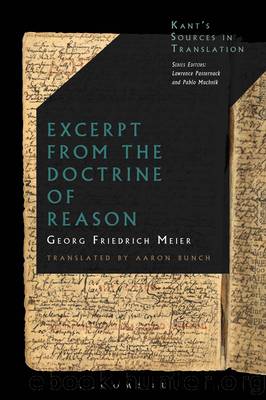Excerpt From the Doctrine of Reason by Georg Friedrich Meier;

Author:Georg Friedrich Meier;
Language: eng
Format: epub
ISBN: 9781474229326
Publisher: Bloomsbury UK
Published: 2015-01-15T00:00:00+00:00
Tenth Section[AA 16: 704]
Of Learned Rational Inferences
§353. If some true judgments contain the sufficient ground of the truth of another, then they are combined with each other §15, and the connection of truths (nexus veritatum) consists in this relation of true judgments.
§354.[AA 16: 705] A rational inference (ratiocinium) is a distinct representation of the connection of truths; which, if it is perfect to a higher degree, is called a learned or a logical rational inference (ratiocinium logicum, eruditum).
§355.[AA 16: 706] In a rational inference we derive a truth from other truths §353, 354. And since these other truths are grounds of proof of the first §191, we make a rational inference when we distinctly derive a truth from its grounds of proof. Consequently, the distinct representation of the consequence of a proof is a rational inference §191.
§356. That judgment which is derived from others in a rational inference is the conclusion (conclusio, probandum, principiatum). But those judgments from which the conclusion is derived are the premises (praemissae, data, sumtiones, principia).
§357.[AA 16: 710] The subjects and predicates of judgments in which a rational inference consists are called the terms [Hauptbegriffe] of a rational inference (termini). The subjec[AA 16: 711]t of the conclusion is the minor term (terminus minor), but its predicate is the major term (terminus maior). The term that is found in the premises, besides the minor and the major, is called the middle term (terminus medius).
§358. Since the premises contain the ground of proof of the conclusion §355. 356, but, besides the parts of the conclusion, nothing more is contained in them than the middle term §357; so the middle term is the ground of proof §191[AA 16: 712], and consequently, the condition of the conclusion §297. Thus, one finds the middle [100] term according to the instructions of the 297th and 298th paragraphs; and a rational inference consists in our derivation of a judgment from its condition in a distinct way §355.
§359. The matter of the rational inference (ratiocinii materia) consists in its premises, but its form (ratiocinii forma) consists in the consequence of the conclusion from the premises [in der Folge des Schlussurtheils aus den Vorderurtheilen].
§360. A correct rational inference (ratiocinium verum) must be correct in the matter as well as in the form §359. 355. 193. Thus, if either the matter or the form is false, or both at the same time,[AA 16: 713] then it is a false incorrect rational inference (ratiocinium falsum). An erroneous rational inference (ratiocinium erroneum) is a false rational inference insofar as it is held to be a correct one §109. If a rational inference has a demonstrative certainty or not is evident from §193 and 194.
§361.[AA 16: 714] Because the consequence in every rational inference must be distinct §355, but no distinctness is possible without order §142, the judgments of a rational inference must be arranged together in the proper way. Now since no order is possible without rules, certain rules of inference are necessary according to which a rational inference must be set up if it should have a correct and distinct consequence.
Download
This site does not store any files on its server. We only index and link to content provided by other sites. Please contact the content providers to delete copyright contents if any and email us, we'll remove relevant links or contents immediately.
The remains of the day by Kazuo Ishiguro(8419)
Tools of Titans by Timothy Ferriss(7833)
Giovanni's Room by James Baldwin(6830)
The Black Swan by Nassim Nicholas Taleb(6786)
Inner Engineering: A Yogi's Guide to Joy by Sadhguru(6455)
The Way of Zen by Alan W. Watts(6294)
Asking the Right Questions: A Guide to Critical Thinking by M. Neil Browne & Stuart M. Keeley(5370)
The Power of Now: A Guide to Spiritual Enlightenment by Eckhart Tolle(5355)
The Six Wives Of Henry VIII (WOMEN IN HISTORY) by Fraser Antonia(5246)
Astrophysics for People in a Hurry by Neil DeGrasse Tyson(5008)
12 Rules for Life by Jordan B. Peterson(4168)
Housekeeping by Marilynne Robinson(4075)
The Ethical Slut by Janet W. Hardy(4045)
Skin in the Game by Nassim Nicholas Taleb(3983)
Double Down (Diary of a Wimpy Kid Book 11) by Jeff Kinney(3941)
Ikigai by Héctor García & Francesc Miralles(3907)
The Art of Happiness by The Dalai Lama(3855)
Skin in the Game: Hidden Asymmetries in Daily Life by Nassim Nicholas Taleb(3739)
Walking by Henry David Thoreau(3699)
